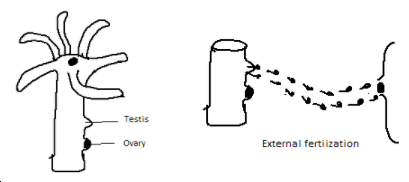
The figure of Hydra shows its reproductive structures and manner of fertilisation.
Observe and answer why it is not showing self fertilisation.

A)Distance between testis and ovary is more
B)Sperms do not swim downwards
C)Ovary matures earlier than testis
D)Testis matures earlier than ovary

Answer
543.6k+ views
Hint: The fertilization of an ovum from one person with another's spermatozoa is allogamy or cross-fertilization. Autogamy, by contrast, is the term used for self-fertilization. In hermaphroditic species, self-fertilization occurs when the two gametes fuse in fertilization come from the same entity.
Complete answer:
In Hydra, cross-fertilisation occurs. The testis matures faster than the ovary matures. Spermatozoa released from one Hydra's testis swim in water with their tails and ultimately come into contact with another's ovum. Hydra. Since it is exposed, Ovum survives only for a brief period. Fertilisation must take place during this time. therefore, this diagram does not demonstrate self-fertilisation and represents cross-fertilisation. A new bud may be produced every two days when a hydra is well fed.
Sexual reproduction happens in some hydra when conditions are extreme, often before winter or in bad feeding conditions. In the body wall, swellings form into either the ovaries or the testes. Morphallaxis (tissue regeneration) is undergone by Hydra when wounded or severed. Usually, by only budding off a whole new individual, Hydras reproduce, the bud can occur about two-thirds of the way down the axis of the body.
Hence, the correct answer is option (D)
Note: The nervous system of Hydra is a nervous net which, relative to more derived animal nervous systems, is structurally basic. Hydra does not have a brain or real organs that can be understood. Sensory photoreceptors and touch-sensitive nerve cells found in the body wall and tentacles are connected by nerve nets.
Complete answer:
In Hydra, cross-fertilisation occurs. The testis matures faster than the ovary matures. Spermatozoa released from one Hydra's testis swim in water with their tails and ultimately come into contact with another's ovum. Hydra. Since it is exposed, Ovum survives only for a brief period. Fertilisation must take place during this time. therefore, this diagram does not demonstrate self-fertilisation and represents cross-fertilisation. A new bud may be produced every two days when a hydra is well fed.
Sexual reproduction happens in some hydra when conditions are extreme, often before winter or in bad feeding conditions. In the body wall, swellings form into either the ovaries or the testes. Morphallaxis (tissue regeneration) is undergone by Hydra when wounded or severed. Usually, by only budding off a whole new individual, Hydras reproduce, the bud can occur about two-thirds of the way down the axis of the body.
Hence, the correct answer is option (D)
Note: The nervous system of Hydra is a nervous net which, relative to more derived animal nervous systems, is structurally basic. Hydra does not have a brain or real organs that can be understood. Sensory photoreceptors and touch-sensitive nerve cells found in the body wall and tentacles are connected by nerve nets.
Recently Updated Pages
The number of solutions in x in 02pi for which sqrt class 12 maths CBSE

Write any two methods of preparation of phenol Give class 12 chemistry CBSE

Differentiate between action potential and resting class 12 biology CBSE

Two plane mirrors arranged at right angles to each class 12 physics CBSE

Which of the following molecules is are chiral A I class 12 chemistry CBSE

Name different types of neurons and give one function class 12 biology CBSE

Trending doubts
One Metric ton is equal to kg A 10000 B 1000 C 100 class 11 physics CBSE

Explain zero factorial class 11 maths CBSE

What is 1s 2s 2p 3s 3p class 11 chemistry CBSE

Discuss the various forms of bacteria class 11 biology CBSE

State the laws of reflection of light

Difference Between Prokaryotic Cells and Eukaryotic Cells




